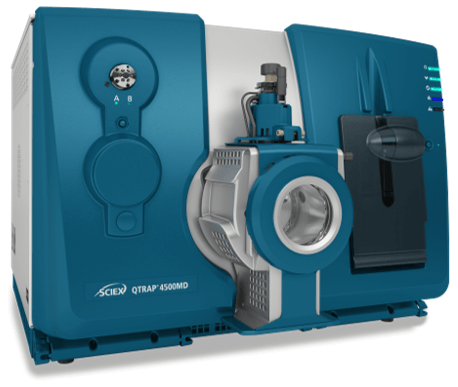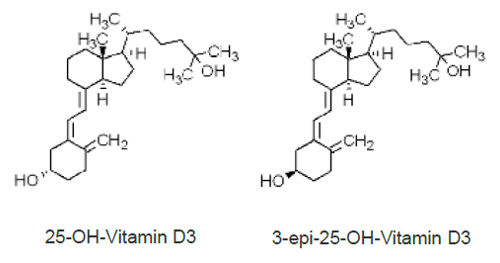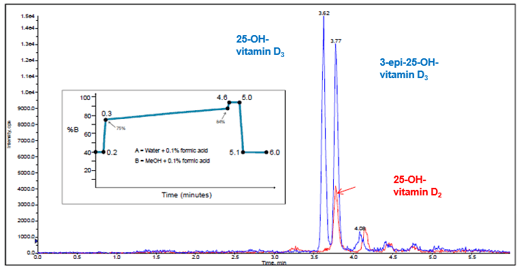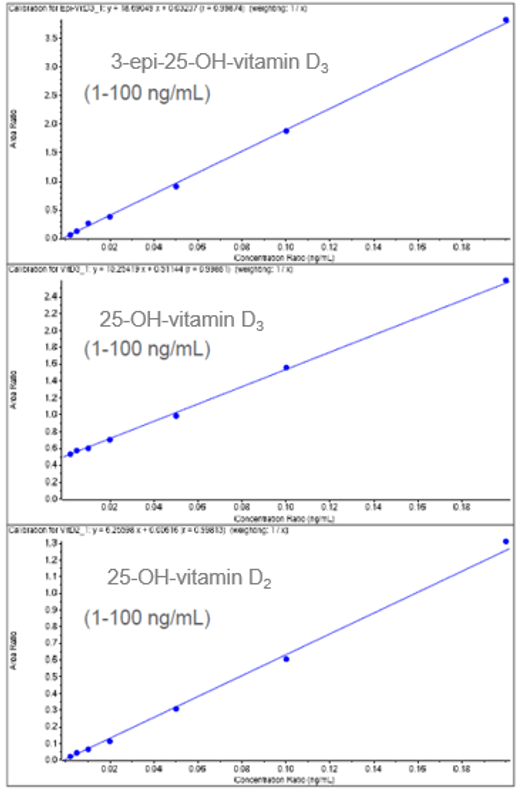Measurement of 25-OH-vitamin D3 and 3-epi-25-OH-vitamin D3 by LC-MS/MS
Using the SCIEX Triple Quad 4500 system
Abstract
Because of the similarity in chemical structure, 25-OH-vitamin D3 and 3-epi-25-OH-vitamin D3 produce the same fragment ions when analysed by MS/MS. It is therefore necessary to resolve these epimers chromatographically when analysis is performed in this way. An LC-MS/MS method has been developed utilizing a Phenomenex Kinetex PFP column that achieves baseline separation of 25-OH-vitamin D3 and 3-epi-25-OH-vitamin D3 in a total run time of 6 minutes, allowing the independent quantification of both 25-OH Vitamin D3 and 3-epi-25-OH Vitamin D3 in a single LC-MS/MS analysis.

Introduction
Because of the similarity in chemical structure (see Figure 1), 25-OH-vitamin D3 and 3-epi-25-OH-vitamin D3 display very similar chromatography and produce the same fragment ions when subjected to collisionally-induced dissociation (CID) in a triple quadrupole mass spectrometer. Since it is not possible to distinguish these epimers by tandem mass spectrometry alone, it is necessary to resolve these epimers chromatographically, to avoid the overestimation of 25-OH-vitamin D3 levels when analysis is performed by LC-MS/MS.
An LC-MS/MS method has been developed utilizing a Phenomenex Kinetex PFP column that achieves baseline separation of 25-OH-vitamin D3 and 3-epi-25-OH-vitamin D3 in a total run time of 6 minutes, employing a shallow gradient consisting of water and methanol with formic acid. ‘Blank’ stripped serum and spiked serum samples have been analyzed to determine LOD and LOQ for the method.
The method developed here allowed the independent quantification of both 25-OH Vitamin D3 and 3-epi-25-OH Vitamin D3 in a single LC-MS/MS analysis. The estimated limit of quantification was approximately 2 ng/mL for each analyte, and the method displayed good accuracy, reproducibility, and linearity over a concentration range from 1-100 ng/mL.
Figure 1. Structures of 25-OH-vitamin D3 epimers.
Methods
Sample Preparation: The sample preparation consisted of a simple liquid-liquid extraction, using hexane, followed by dry-down and reconstitution of the sample:
- 200 µL of plasma was measured into a 1.5mL polypropylene microcentrifuge tube.
- 200 µL of internal standard solution (25-OH-vitamin D3-d6) was added to each tube, which was then vortex mixed for 15 seconds to precipitate proteins
- 1 mL of hexane was added to each sample, which was vortex mixed for 15 seconds
- The samples were centrifuged at 14,000 rpm for approximately 15 minutes, until the upper hexane layer was free of particulates.
- 800 µL of the supernatant was transferred into a clean 1.5 mL microcentrifuge tube and dried down under nitrogen gas at 45°C.
- The dried sample was reconstituted using 175 µL of methanol:water
HPLC conditions: Chromatographic separation was accomplished using a Phenomenex Kinetex PFP analytical column (100 x 3.0 mm, 2.6 µn, 100A) with a SecurityGuard C18 cartridge (4 x 3 mm). The UHPLC method employed a binary gradient, at a flow rate of 400 µL / minute. Mobile phase A consisted of water with formic acid, and mobile phase B consisted of methanol with formic acid.
MS/MS conditions: MS/MS detection was accomplished using the SCIEX Triple Quad™ 4500 LC-MS/MS System, equipped with Turbo V™ Ion Source, operated in positive electrospray ionization (ESI) mode. The multiple reaction monitoring (MRM) mode of operation was used, with 2 MRM transitions monitored per analyte. The deuterated analogue of 25-OH-vitamin D3 was used as an internal standard for all the analytes.
Results
A rapid, 6-minute LC-MS/MS method has been developed for the quantification of 25-OH-vitamin D3, 3-epi-25-OH-vitamin D3, and 25-OH-Vitamin D2 in a single analysis, using the SCIEX Triple Quad™ 4500 LC-MS/MS system. Chromatographic separation was accomplished using a Phenomenex Kinetex PFP (2.6 µm, 100 x 3mm) analytical column. Using this binary flow gradient, it was possible to reduce the total run-time of the method to just 6 minutes, while still achieving baseline separation of 25-OH-vitamin D3 and 3-epi-25-OH-vitamin D3. This method also provided much narrower peak widths (approximately 0.1 minutes), resulting in improved S/N, and therefore more sensitive detection of the target analytes. An example chromatogram of the separation achieved is shown in Figure 2.
Figure 2. Separation of 25-OH-vitamin D3 and 3-Epi-25-OH-Vitamin D3 using a 6-minute binary flow gradient
The performance of the method was evaluated using spiked serum samples covering a concentration range of 1-100 ng/mL. Representative calibration curves for the 3 analytes are shown in Figure 3. The lower limits of quantification (LLOQ) for the method were determined to be approximately 1ng/mL, 2ng/mL, and 1ng/mL, for 3-epi-25-OH-vitamin D3, 25-OH-vitamin D3, and 25-OH-Vitamin D2, respectively. The accuracy of the measurements for each analyte ranged from 83-119% over the entire concentration range, including at the LLOQ. The method displayed excellent linearity over the concentration range from 1-100 ng/mL, with r>0.998 for each analyte. Levels for these same samples had been determined previously using an established LC-MS/MS method, thus allowing for a direct comparison of the two analytical techniques.
Figure 3. Calibration curves for 3-epi-25-OH-vitamin D3, 25-OH-vitamin D3, and 25-OH-Vitamin D2.
Conclusions
A rapid LC-MS/MS method has been developed to allow the simultaneous, and independent quantification of 25-OH-vitamin D3, 3-epi-25-OH-vitamin D3, and 25-OH-Vitamin D2, with a run-time of only 6 minutes. Liquid-liquid extraction with hexane is used to clean up the serum samples prior to analysis using the SCIEX Triple Quad™ 4500 LC-MS/MS System. Chromatographic separation of the 25-OH-vitamin D3 epimers is accomplished using a Phenomenex Kinetex PFP analytical column, employing a simple binary gradient at a flow rate of 400 µL/min.
 Click to enlarge
Click to enlarge Click to enlarge
Click to enlarge Click to enlarge
Click to enlarge